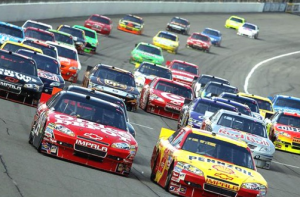Why NASCAR Needs To Think About Energy Use
 From constant travel to keeping the stadium lights on, every sport is energy intensive. But NASCAR — in which drivers race vehicles 500 miles at speeds of 200 miles per hour — takes energy intensity to a whole new level.
From constant travel to keeping the stadium lights on, every sport is energy intensive. But NASCAR — in which drivers race vehicles 500 miles at speeds of 200 miles per hour — takes energy intensity to a whole new level.NASCAR is arguably the second most popular sport in America. Though it lacks some of the broad appeal of other sports, the 75 million people that watch it each weekend put the sport behind only the NFL in popularity. And that popularity has its environmental impact beyond what the casual fan might think about.
For example, NASCAR race cars are not subject to the EPA regulations that govern other vehicles on the road. They do not have catalytic converters mandated for every other car on the road. And until 2007, NASCAR used leaded gas — a toxic fuel that has hasn’t been used in the rest of the U.S. since the 1980s.
On average, NASCAR cars get between 2 and 5 miles per gallon of gas. How Stuff Works explains:
“In a single typical NASCAR race weekend, with more than 40 cars at high speeds for 500 miles (804 kilometers) — plus practice laps — at 5 mpg of gas, you’re looking at, conservatively, about 6,000 gallons (22,712 liters) of fuel [source: Finney]. Each gallon burned emits about 20 pounds (9 kilograms) of carbon dioxide, so that’s about 120,000 pounds (54,431 kilograms) of CO2 for a race weekend [source: FuelEconomy]. Multiply that by roughly 35 races per year, and NASCAR’s annual carbon footprint is in the area of 4 million pounds (1.8 million kilograms).”
Four million pounds certainly isn’t going to tip the climate over the edge, but its still a heck of a lot of CO2 spewed into the atmosphere. And that number doesn’t even include the fleet of diesel powered support vehicles that accompany each racing team at every event around the country.
NASCAR has been mildly cooperative in making its sport more “green.” In 2011, they introduced an ethanol based additive, E15, into the racing fuel. This increased the power generated by the fuel, but it did so by reducing efficiency significantly.
Beyond just the fuel, NASCAR cars go through a lot of tires. In fact, each team uses approximately 8-10 sets of tires per weekend. The tires are made primarily with synthetic rubber and therefore require oil to produce. According to the Rubber Manufacturers Association, it takes about 7 gallons of oil to make one tire.
Assuming we have the 40 racers we had when we looked at fuel consumption, and, conservatively, 8 sets of tires per racer, then NASCAR uses about 8,960 gallons of oil per race weekend on tires alone. Its a little tough to tell how much CO2 is emitted when oil is burned, but one estimate places the number at about 317 kg (or 698.86 lbs) per barrel. That amounts to roughly 149,090 lbs of CO2 emitted into the air per weekend.
Again, that number doesn’t take into account any of the support vehicles needed to make the races happen, just the actual race cars.
When taking into account all the other factors that aren’t unique to this sport — the cars the fans drive to the game/race, the air travel, the TV crews, the land used for stadiums/racetracks, the lights — it’s clear just how much impact NASCAR has on the environment.
Does that mean we need to stop it? Of course not.
NASCAR is exciting. The cars go extremely fast and the action is non-stop. The sport shouldn’t be abolished any more than baseball, hockey, or football. Instead, the leadership at NASCAR should take car racing’s energy use seriously and consider new ways to grow the sport and entertain fans — all while helping develop new, less energy-intensive technologies.
You can return to the main Market News page, or press the Back button on your browser.

